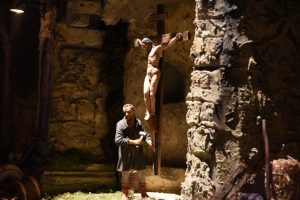A Nativity Scene with a Twist
 While the life-size nativity scene (presepio) in piazza Duomo is impressive enough, hosted in piazza Santo Spirito is a new crèche, as never seen before.
While the life-size nativity scene (presepio) in piazza Duomo is impressive enough, hosted in piazza Santo Spirito is a new crèche, as never seen before.
What makes this design so special? While the presepio typically recreates the setting of the birth of Christ, it also portrays a mysterious character. Seen to be hammering a wooden cross in place (to which Jesus is attached), the figurine is believed to be Michelangelo, the precise author of the Crucifix sculpture donated to the Augustinian community of Santo Spirito in 1492.
A young 17-year-old Michelangelo attended the San Marco sculpture academy, following the Lorenzo the Magnificent’s request for him to join. After his patron and guardian, Lorenzo’s death, Michelangelo became a guest of the convent of Santa Maria del Santo Spirito where he studied the human anatomy from the corpses found in the convent’s hospital. With this inspiration, the artist then created the crucifix, which is now placed in the Basilica of Santo Spirito.
The miniature Crucifixion of Christ in the crèche is juxtaposed with the grotto in which the birth of Jesus is portrayed. With the two being placed side by side, it almost creates an unavoidable link between both birth and death – one cannot exist without the other.
A CLOSER LOOK INTO THE SET
Francesco Artese (author of the nativity scene) depicts 110 characters in this masterpiece set amongst the ancient architecture of Matera. Each character, whether it be women, men or children portray daily activities of rural life, with the backdrop being the rustic and agricultural areas of Basilicata (southern Italian region made up mainly of forests and mountains). Shepherds herd their flock of sheep, villagers collect their water from the well, housewives hang their washing from their balconies and farmers gather their hay with the help of donkeys, while others are dancing and playing instruments around the streets.
One area of the scene centres on the Maggio di Accettura, a yearly procession in which women carry above their heads a crown made entirely from candles.
Another tradition visually represented is that of the ‘Festa della Bruna,’ a festival to celebrate the Virgin Mary. Legend says that a farmer once gave a young woman a ride in his carriage to Matera, and once they arrived the lady requested the man to pass on a message to the bishop; to say that he had given the Virgin Mary a lift. When the Bishop and the whole town heard of such a word, they ran down to find the lady, however all they managed to find was a statue of the Madonna of Bruna, patron saint of Matera. In order to remember and re-tell the story, the town now holds this procession in which villagers carry a wax cart copy of the church depicting the Madonna of Bruna.
While characters are frozen in time, the background will adapt to our present time, with a blue bright sky during daytime visits and a dark blue starry backdrop during the evening. Light emanating from depicted house windows and moon twinkle in the darkness.
To see the nativity scene up-close the public can visit the Basilica of Santa Spirito until February 4.
To read more in Italian and to see a full photo gallery visit Florence’s La Repubblica news site. (karen gee)
